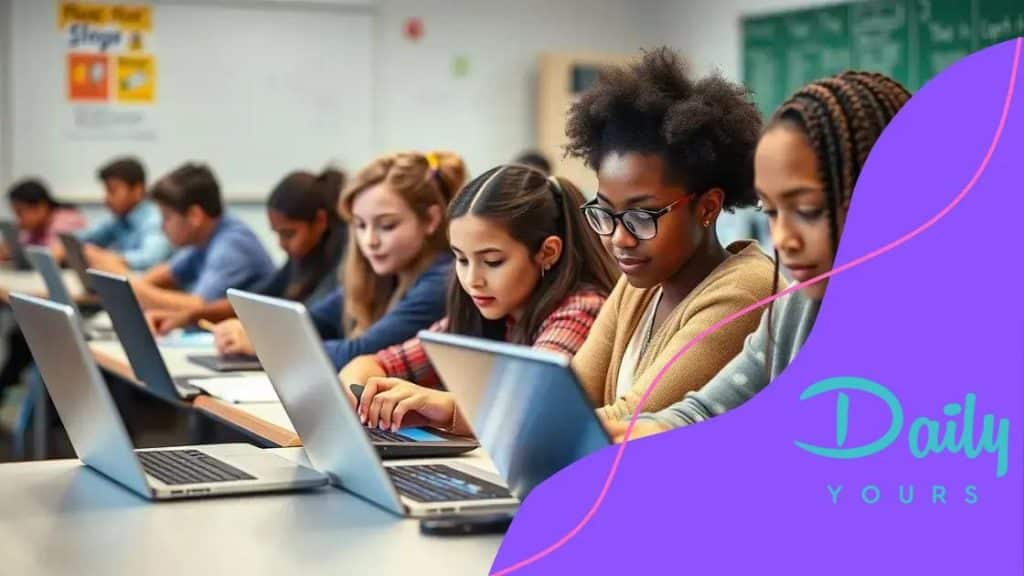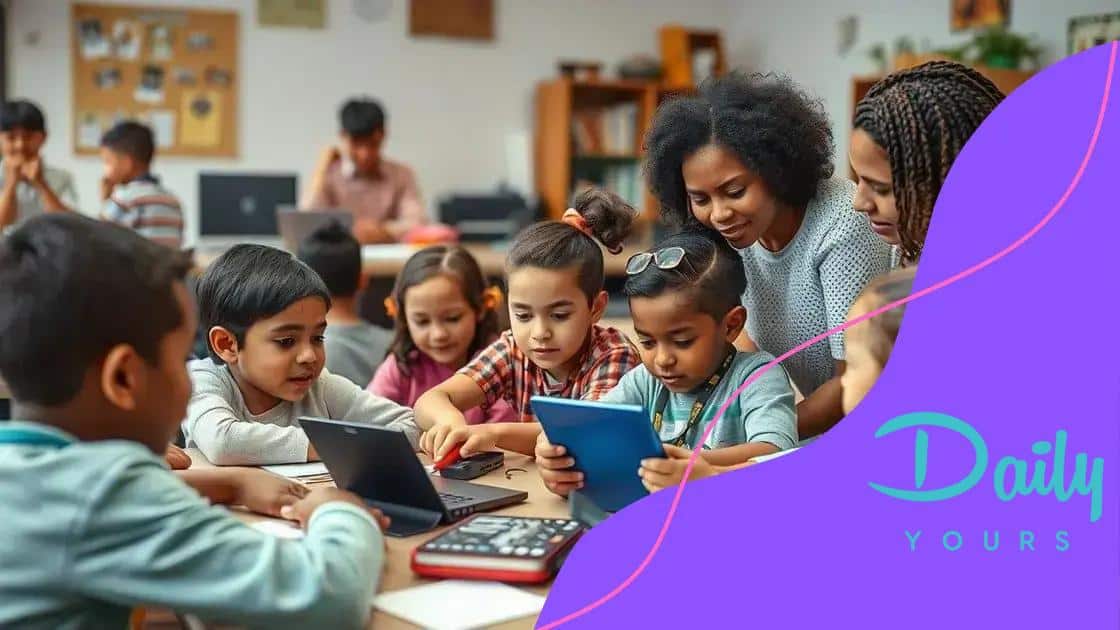Bridging the digital divide in education systems

Anúncios
Bridging the digital divide in education ensures equal access to technology and learning resources, enabling all students to succeed in a modern educational landscape.
Bridging the digital divide in education systems is more important than ever, as it directly impacts students’ learning experiences. Have you considered how technology access affects educational outcomes? In this article, we’ll delve into the challenges and strategies for creating a more equitable education environment.
Anúncios
Understanding the digital divide in education
Understanding the digital divide in education is essential in today’s technology-driven world. The concept refers to the gap between those who have easy access to digital technology and those who do not. Particularly in educational settings, this divide can affect students’ learning opportunities significantly.
This gap manifests in various ways, including lack of internet access, insufficient technology resources, and varying levels of digital literacy. Addressing these barriers is key to ensuring that all students can thrive in a digital world. Let’s look closer at the elements contributing to the digital divide.
Key Factors of the Digital Divide
This divide arises from multiple factors, and it is crucial to recognize them:
Anúncios
- Socioeconomic Status: Families with higher income levels typically have better access to technology.
- Geographic Location: Rural areas often have less reliable internet service compared to urban centers.
- Educational Resources: Schools in wealthier districts may offer more technology support than those in low-income areas.
- Digital Literacy: Knowledge and skills to effectively use technology can vary widely among students.
As these factors interconnect, the impact of the digital divide on education becomes clearer. For instance, students without proper access to technology may struggle with remote learning during emergencies. They could miss out on vital educational content and experiences. This scenario highlights why understanding and addressing the digital divide is crucial for educational equity. Individual and community efforts can significantly improve the situation by enhancing technology access and training.
Investment in community initiatives can also play a significant role in bridging this gap. Many organizations are working toward providing resources, including low-cost internet solutions and technology training for families. These grassroots efforts can empower communities to advocate for better educational resources and access.
To effectively combat the digital divide, comprehensive strategies are necessary. Educational institutions must actively work to close these gaps by collaborating with technology companies, local governments, and nonprofits. By fostering partnerships, they can create solutions that address both immediate needs and long-term access to technology.
Key challenges in educational technology access
Key challenges in educational technology access are significant hurdles that schools and students face today. These challenges greatly affect learning experiences and outcomes. Understanding these obstacles is vital for designing effective solutions.
One of the primary challenges is technology availability. Many schools lack the necessary devices for students, such as laptops and tablets. This lack hampers students’ ability to engage in digital learning. Additionally, insufficient infrastructure, like poor internet connectivity, makes it difficult for students to access educational resources online.
Financial Constraints
Many educational institutions experience limited budgets that restrict their ability to invest in technology. Without adequate funding, schools struggle to provide both hardware and software necessary for modern learning environments.
- Budget limitations: Many schools cannot afford new technology updates.
- Cost of maintenance: Ongoing costs for tech support can deter schools from improving their resources.
- Shortage of digital materials: High-quality digital curriculum materials are often expensive and not widely available.
The issue of digital literacy also plays a crucial role. Not all students or teachers are equipped with the skills to use technology effectively. This gap can lead to frustrations and hinder learning. Professional development for educators is essential to ensure they feel confident in teaching with technology.
Furthermore, there are disparities in home access to technology. Some students may have reliable internet at home, while others may rely on public resources, like libraries, which may not always be available. This inconsistency puts students at various advantages and disadvantages.
Addressing these challenges requires collaboration among schools, governments, and communities. Solutions can include increasing funding for technology, providing consistent training for educators, and developing community programs to ensure all students have access to the tools they need for learning.
Strategies for bridging the digital divide

Strategies for bridging the digital divide are essential to ensure all students have equal educational opportunities. By implementing effective solutions, we can help level the playing field in education.
One important strategy is improving access to affordable technology. Schools can partner with tech companies to provide devices to students at lower costs. These partnerships can also include maintenance support, ensuring that technology remains functional.
Community-Based Initiatives
Community involvement is another effective approach. Local organizations can create programs that offer technology training and resources. Such initiatives help families understand how to use technology for learning.
- After-school programs: These can provide safe spaces for students to use technology and receive guidance.
- Internet access points: Establishing free Wi-Fi zones in neighborhoods can help students who lack home internet.
- Workshops for parents: Teaching parents how to assist their children with technology can enhance learning.
Another strategy involves integrating digital literacy education into classrooms. Teaching students how to use technology effectively prepares them for the future. This education should cover not only how to use devices but also how to navigate the internet safely.
School policies can also play a vital role in bridging the divide. Creating clear guidelines on technology use ensures that all students benefit equitably. Schools should prioritize training for teachers, enabling them to support students in a digital environment.
Collaboration among various stakeholders is critical for success. This includes local governments, schools, and community organizations working together to secure funding and resources. Joint efforts can amplify the impact of individual strategies, making them more effective.
The role of community initiatives
The role of community initiatives in bridging the digital divide is pivotal. Local organizations and community members play an integral part in providing resources and support to improve access to technology.
Many communities have started programs aimed at enhancing digital literacy. These initiatives often include workshops that teach essential technology skills. They can help individuals understand how to use devices and access online resources effectively. This type of training can empower individuals, enabling them to succeed in an increasingly digital world.
Collaborative Efforts
Community initiatives often involve partnerships between schools, libraries, and nonprofit organizations. These collaborations create a network of support for students and families.
- After-school programs: These provide a safe environment for students to use technology with guidance from trained staff.
- Access to resources: Libraries can offer free internet access and computer use, helping those without technology at home.
- Mentorship programs: These pair tech-savvy volunteers with students, giving them personalized support.
In addition to training, some communities organize events that aim to provide free or low-cost technology devices. These events can significantly reduce the financial barriers many families face. By distributing laptops or tablets, communities help ensure that students have the tools they need to learn.
Local businesses can also support these initiatives by donating funds or technology. Their involvement not only aids the community but fosters a sense of corporate responsibility. Many companies find it rewarding to invest in local education efforts.
When communities unite to tackle the challenges of the digital divide, they create a ripple effect of improvement. With stronger support networks, families are better equipped to navigate the complexities of modern education.
Future trends in educational equity
Future trends in educational equity are shaping how we view and implement access to learning resources. As technology continues to evolve, so do the opportunities for creating a more equal educational landscape.
One significant trend is the move towards personalized learning. Schools are beginning to leverage technology to tailor educational experiences to each student’s needs. This approach ensures that students receive the support they need to succeed, regardless of their background or resources.
Increased Use of Technology
With the rise of online platforms, educators can reach more students than ever. Distance learning tools have become essential, especially in times of crisis. These technologies can provide access to quality educational materials and direct instruction, improving learning outcomes for all.
- Adaptive learning systems: These systems use data to adjust content based on student performance.
- Virtual classrooms: Students can learn from anywhere, expanding access to quality education.
- Collaborative tools: Platforms that allow students to work together foster learning and connection.
Another trend is the focus on social-emotional learning (SEL). Recognizing that emotional well-being is vital for academic success, schools are incorporating SEL into their curriculums. By addressing students’ mental health and emotional needs, educators can create a more supportive and inclusive environment.
Additionally, more emphasis is being placed on community engagement. Schools and communities are forming partnerships to address local educational needs. These partnerships can provide resources and support to help close the gap in access to technology and educational opportunities.
As we look to the future, the focus on equity in education will likely continue to grow. Policymakers and educators are recognizing the importance of fair access to technology and resources. By implementing these trends, we can work towards a more equitable education system for all students.
FAQ – Frequently Asked Questions about Bridging the Digital Divide in Education
What is meant by the digital divide in education?
The digital divide in education refers to the gap between those who have easy access to digital technology and online resources, and those who do not.
How can community initiatives help in bridging the digital divide?
Community initiatives can provide resources, technology training, and support for families to improve access to technology and enhance digital literacy.
What are some effective strategies for improving educational equity?
Effective strategies include implementing personalized learning, increasing access to technology, and fostering partnerships between schools and local organizations.
Why is digital literacy important in education?
Digital literacy is crucial as it equips students with the skills needed to navigate online resources effectively, improving their learning outcomes and opportunities.





